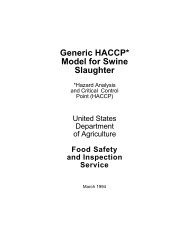Generic HACCP Model for Thermally Processed Commercial
Generic HACCP Model for Thermally Processed Commercial
Generic HACCP Model for Thermally Processed Commercial
You also want an ePaper? Increase the reach of your titles
YUMPU automatically turns print PDFs into web optimized ePapers that Google loves.
1<br />
following the production steps involved in the particular product or process.<br />
Hazard Analysis: The Hazard Analysis is a critical step in the development of a plantspecific<br />
<strong>HACCP</strong> plan. This portion of plan development must take into consideration the<br />
risk or likelihood of occurrence, and the severity of each hazard. In order to be<br />
considered, an identified hazard must be "of such a nature that its prevention, elimination,<br />
or reduction to an acceptable level is essential to the production of a safe food.” Hazards<br />
that are not significant or not likely to occur will not require further consideration. The<br />
potential significance of each hazard should be assessed according to its frequency, risk,<br />
and severity. "Risk is an estimate of the likely occurrence of a hazard. The estimate of<br />
risk is usually based on a combination of experience, epidemiological data, and<br />
1<br />
in<strong>for</strong>mation in the technical literature." For example, it is well documented that during<br />
the process of poultry slaughter, salmonella is an organism of public health significance<br />
that constitutes a risk of sufficient severity <strong>for</strong> inclusion into a <strong>HACCP</strong> plan <strong>for</strong><br />
identification and description of preventive measures. If the plan does not take into<br />
consideration the points at which the growth and proliferation of this organism can occur,<br />
and identify appropriate preventive measures, a safe food will not be produced.<br />
Pathogenic microorganisms of public health significance should be identified in the Hazard<br />
Analysis under the appropriate process step as a biological hazard with preventive<br />
measures to preclude their growth and proliferation.<br />
Remember that in your hazard analysis there are three categories of hazards to consider:<br />
chemical, biological, and physical, Appendix 3 includes a table of hazards that are<br />
controlled in a <strong>HACCP</strong> program. Each process step will be evaluated to determine if<br />
significant hazards from one or more of these categories are present. The hazards will be<br />
listed at each process step along with the specific preventive measures that can control<br />
the hazard. For example, if your plant-specific <strong>HACCP</strong> plan identifies <strong>for</strong>eign material<br />
as a physical hazard <strong>for</strong> receiving non-meat ingredients, a preventive measure must be<br />
included ensuring that the materials are handled and stored in a manner so as not to<br />
contaminate the product.<br />
If conclusive epidemiological data are available, this in<strong>for</strong>mation should be used to<br />
determine the appropriate preventive measure: cooking or cooling temperatures, use of<br />
antimicrobial rinses, etc.<br />
Identify the processing steps that present significant hazards and any preventive measures<br />
on the Hazard Analysis/Preventive Measures Form. These will be derived from the<br />
process steps on your flow diagram. This activity is one of the major portions of the<br />
Hazard Analysis. The use of technical literature, epidemiological data, and assistance<br />
from an individual with <strong>HACCP</strong> training at least as described in 9CFR 417 is crucial at<br />
this point to ensure that adequate preventive measures have been identified and significant<br />
NACMCF, <strong>HACCP</strong>, 1992<br />
4



